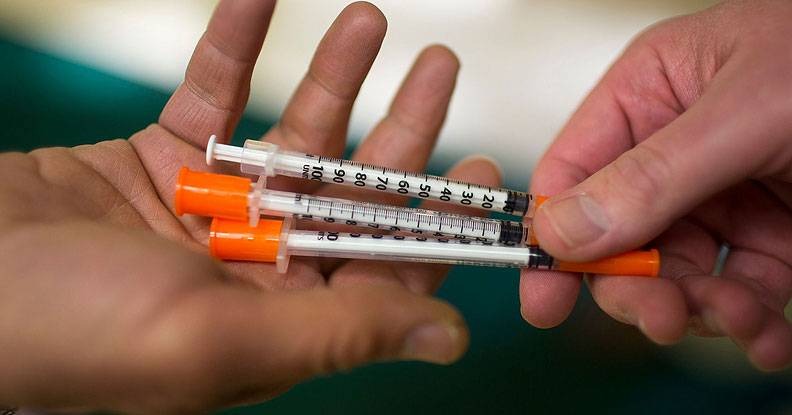The Controversy Around Needle Exchange: Enabling Drug Use or Saving Lives?
The controversy around needle exchange: Are we enabling drug use or are we saving lives? The public health debate rarely asks whether this harms the societal fabric.
HARM REDUCTION & PREVENTION


Introduction to Needle Exchange Programs
Needle Exchange Programs (NEPs) are public health initiatives designed to provide individuals who use intravenous drugs with sterile needles while safely disposing of used ones. Their primary objective is to reduce the transmission of blood-borne infections, such as HIV and Hepatitis C, among drug users and the broader community. Established in the mid-1980s, NEPs emerged as a response to the growing HIV epidemic, particularly among populations at risk due to injection drug use. By offering a means to access clean injecting equipment, these programs aim to mitigate the health risks associated with shared needles.
Over the years, NEPs have evolved to address not only the distribution of sterile needles but also to provide comprehensive health services, including testing for infectious diseases, referral to treatment programs, and access to counseling and education on safer drug use practices. They serve various populations, including homeless individuals, marginalized communities, and those engaged in illicit drug use. The implementation of NEPs varies by region, reflecting the unique social, cultural, and political contexts that influence drug policy and public health approaches.
The controversy surrounding needle exchange programs often stems from differing perspectives on drug use and public health. Critics argue that NEPs may inadvertently enable drug use by providing easier access to needles. In contrast, proponents maintain that these programs play a crucial role in harm reduction, ultimately saving lives and reducing healthcare costs associated with treating drug-related infections. As the debate continues, it is essential to consider the evidence and understand the varied functions of NEPs as part of a broader strategy to address the complex issues surrounding substance use and its public health implications.
Understanding the Arguments for Needle Exchange Programs
Needle exchange programs (NEPs) have emerged as a pivotal component in the public health discourse surrounding drug use. These programs are designed to reduce the transmission of bloodborne diseases, such as HIV and hepatitis C, among individuals who inject drugs. Evidence supporting the efficacy of NEPs is multifaceted, encompassing statistical data, public health insights, and personal testimonials.
Research indicates that communities hosting needle exchange programs experience significant reductions in disease transmission rates. For instance, a comprehensive study found that NEPs can lead to a decrease in HIV transmission by up to 80% in certain populations. This stark statistic underscores the ability of these initiatives to mitigate health crises related to drug use, providing accessible resources that empower individuals to protect their health without facing legal repercussions.
Public health officials widely advocate for needle exchanges as an essential harm reduction strategy. Organizations such as the World Health Organization and the Centers for Disease Control and Prevention reference NEPs in guidelines aimed at combating the spread of infectious diseases linked to drug use. These endorsements emphasize that needle exchange programs are not only effective in reducing harm but also contribute to broader public health goals, including decreased healthcare costs and enhanced community safety.
Furthermore, many individuals who have participated in needle exchange programs report transformative experiences. Testimonials reveal that these services provide crucial support, including access to healthcare, substance use treatment, and social services. Such narratives illustrate that NEPs can foster a sense of community and belonging among marginalized populations, ultimately leading to better health outcomes and improved social integration.
In essence, the evidence in favor of needle exchange programs highlights their role as a harm reduction strategy that not only safeguards individual health but also promotes a healthier society overall, without encouraging drug use.
Criticism of Needle Exchange Programs
The debate surrounding needle exchange programs is often fraught with strong opinions and divided perspectives. Critics of these programs argue that, rather than addressing the root causes of drug addiction, they may inadvertently enable ongoing drug use by normalizing this behavior within communities. By providing clean syringes and other related services, detractors contend that these programs could create a safety net for individuals addicted to drugs, leading to a higher acceptance of drug use among both users and non-users.
Community members often express concerns that needle exchange programs may contribute to an increase in crime rates. There is a widespread belief that the presence of these programs sends a message of leniency towards drug use, potentially attracting individuals who might not otherwise engage in substance abuse. Some residents fear that such initiatives could change the character of neighborhoods, leading to an increase in drug-related activities and public disturbances. Law enforcement officials also weigh in on the discussion, suggesting that enabling drug users in this way diverts focus from the critical need for stricter enforcement of drug laws and prevention strategies.
Policymakers also share apprehensions about the implications of needle exchange programs on public perceptions of drug use. Many argue that facilitating the exchange of needles could risk depicting drug use as a socially acceptable behavior, undermining ongoing efforts to deter substance abuse and addiction. Critics assert that instead of offering solutions, these programs may perpetuate a cycle of dependency and discourage individuals from seeking treatment for their addiction. This sentiment highlights a complex dilemma faced by communities – balancing harm reduction efforts with the necessity of reducing drug addiction rates and upholding community standards.
Public Perception and Societal Impact
The introduction of needle exchange programs (NEPs) has elicited a complex spectrum of public perceptions, reflecting a range of societal attitudes towards drug use, public health, and community values. Supporters argue that NEPs are essential public health interventions, effectively reducing the transmission of infectious diseases such as HIV and hepatitis C. They contend that these programs contribute positively to community health by providing sterile needles and offering harm reduction resources. Conversely, detractors often view NEPs as enabling drug use, arguing that they may undermine societal norms and perpetuate addiction. This divergence in opinion is influenced by local culture, social attitudes, and broader media narratives surrounding drug use and addiction.
Cultural context plays an instrumental role in shaping public attitudes toward NEPs. In communities where there is a strong emphasis on abstinence and traditional values, resistance to needle exchanges may be more pronounced. Individuals in these areas may perceive NEPs as morally objectionable, fostering a climate of stigma towards users. This can lead to calls for stricter drug policies rather than harm reduction approaches. Conversely, communities that prioritize public health and have experienced the ravages of addiction firsthand may be more supportive of NEPs, viewing them as a compassionate response to a public health crisis.
Media representation also significantly impacts public perception. Sensationalized coverage often highlights the risks associated with NEPs, focusing on individual stories of drug use that evoke emotional responses. Such narratives can skew public understanding and reinforce negative stereotypes about drug users, creating a perception that NEPs harm community cohesion. On the other hand, media outlets that highlight the success stories of NEPs in curtailing disease transmission and facilitating recovery may contribute to a more favorable public perception. Ultimately, the ongoing dialogue about needle exchange programs reflects deep-seated tensions between the imperatives of public health and the values upheld by various communities.
Economic Considerations: Costs vs. Benefits
The implementation of needle exchange programs (NEPs) has sparked considerable debate regarding their economic viability. A central aspect of this ongoing discussion is the contrast between the costs incurred by these programs and the benefits they may yield in terms of public health. Funding for NEPs often relies on a combination of government subsidies, private donations, and community support, which raises questions about sustainability. As taxpayers are a crucial source of funding, understanding the economic implications is vital for public acceptance of such initiatives.
On one hand, needle exchange programs require initial investment for supplies, staffing, and facilities. These upfront costs can be substantial, raising concerns about the allocation of limited public health resources. However, research consistently indicates that the long-term benefits of NEPs often outweigh their costs. By providing clean needles, these programs can significantly reduce the transmission rate of bloodborne diseases such as HIV and hepatitis C, which can be prohibitively expensive to treat. For instance, the costs associated with treating an individual with HIV can exceed $400,000 over their lifetime, whereas the annual cost of running an NEP is considerably lower.
Additionally, NEPs facilitate connections between individuals who use drugs and healthcare services, increasing the likelihood of treatment engagement. This leads to decreased healthcare costs over time, as individuals are less prone to drug-related emergencies and complications. Additionally, economic benefits also manifest through increased productivity and reduced crime associated with untreated substance use disorders. Overall, the evidence suggests that investing in needle exchange programs not only addresses immediate health concerns but also delivers long-term financial dividends for both public health systems and taxpayers.
In conclusion, the economic considerations surrounding needle exchange programs reveal a complex landscape where initial costs may be substantial, yet the potential benefits—ranging from lower healthcare expenses to enhanced public health outcomes—paint a compelling case for their continued support and funding.
Case Studies: Success Stories from Needle Exchange Programs
Needle exchange programs (NEPs) have emerged as crucial interventions in addressing not only drug use but also the serious health consequences associated with it, particularly the transmission of bloodborne diseases. Two compelling examples of successful NEPs can be found in countries such as Switzerland and Australia, both of which demonstrate the efficacy of these programs in promoting public health while mitigating issues related to substance use.
In Switzerland, the city of Zurich initiated one of the first comprehensive NEPs in the 1990s amid a significant drug crisis. The program focused on providing sterile needles, safe consumption spaces, and access to health services for drug users. By 2001, it was reported that the program contributed to a significant reduction in new HIV infections among injecting drug users, which dropped from 1,800 cases in 1990 to less than 100 by 2010. This drastic decline illustrates the potential for needle exchanges to change the tide of disease prevalence while connecting individuals to vital healthcare resources, including addiction treatment and rehabilitation services.
Similarly, Australia established a successful NEP in the mid-1990s, notably in the state of New South Wales. The program not only offers needle exchanges but also incorporates educational resources for safer drug use, leading to significant awareness around the risks associated with injecting substances. Research indicates a 50 percent decline in hepatitis C transmission rates among participants of the program when compared to non-participants. Additionally, the increased accessibility of health services has improved outcomes for many drug users, emphasizing the role of NEPs in encouraging safer practices and facilitating pathways to recovery.
These examples showcase innovative approaches utilized in needle exchange programs, highlighting the importance of tailored solutions to meet the unique challenges faced by different communities. Ultimately, they serve as exemplary models for best practices in public health, promoting not just harm reduction but also enhancing the overall well-being of individuals facing substance use challenges.
Conclusion: Finding a Balance in Public Health Policy
The ongoing debate surrounding needle exchange programs epitomizes the complexities involved in formulating effective public health policies. Proponents argue that these programs play a crucial role in reducing the transmission of infectious diseases such as HIV and hepatitis C among individuals who inject drugs. By providing sterile needles, organizations aim to enhance public health outcomes and ultimately save lives. On the other hand, critics assert that these initiatives may inadvertently enable drug use by normalizing substance abuse and potentially leading to an increase in addiction rates.
A balanced approach is essential for addressing the needs of both public health and community concerns. Needle exchange programs should not be considered in isolation; rather, they must be part of a comprehensive strategy that includes education on drug use, access to rehabilitation services, and support for individuals struggling with substance use disorder. The goal is to provide a continuum of care that encompasses prevention, treatment, and harm reduction while fostering a dialogue with stakeholders at all levels.
To navigate the controversy, continued research is necessary to evaluate the long-term impacts of needle exchanges on both individual and public health outcomes. This research can help inform policymakers and community leaders, guiding them toward evidence-based solutions that respect the diverse views surrounding drug use. Moreover, fostering open discussions within communities can help diminish stigma and promote understanding of the challenges faced by those with substance use disorders.
Ultimately, finding a balance in public health policy regarding needle exchange programs will require collaboration among health professionals, government agencies, and community organizations. By recognizing the potential benefits while addressing concerns, stakeholders can work towards creating an environment that not only aims to save lives but also supports individuals on their journey to recovery.




















